Tenerife

The Condesito sits in 20m of water just outside the harbour at Las Galletas, in the Canaries off the island of Tenerife, she sank following a storm in September of 1973, engine problems having left her at the mercy of the sea and her proximity to the coast. El Condesito, or the “little count” when translated from Spanish, was a typical coaster, at 41m long she had two For’ard main holds and a smaller Stern hold, and on the 27th of September, was carrying cement from the Arguineguin cement factory at El Pajar Beach, Gran Canaria, destined for the construction work being carried out at Los Cristianos, hence locally she is known as “The Cement Wreck”

You would not describe the Condesito as elegant and I doubt she would want you to, El Condesito was function over form every way you look, from her no nonsense bow to her rounded stern, she was built to carry as much cargo as a small sub 50m coaster could carry and in an efficient effective manner, enough to profit from Post War austerity whilst building a new future for her owners. Utility was the necessity and the Western World was familiar with frugality, there were no corners cut on Condesito, nor were there frivolities. The Condesito was a workhorse and could be run with minimal crew to eke out slender profits from cash strapped and often shoe-string businesses, as they tried to re-build what had been destroyed during the last 6 years of war in Europe. The previous 3 years of the Spanish Civil War (prior to WWII), didn’t help, as the Spanish economy was at the point of collapse. The Condor Squadron and military support the Nazis had given General Franco had proven a concept of Blitzkrieg, “Lightening War”, emboldening Hitler’s ambitions for a German Empire, which lead into Hitler’s attempt to impose a “1000 year Reich” on Europe, at the cost of anyone and everyone not willing to buy into that ideal
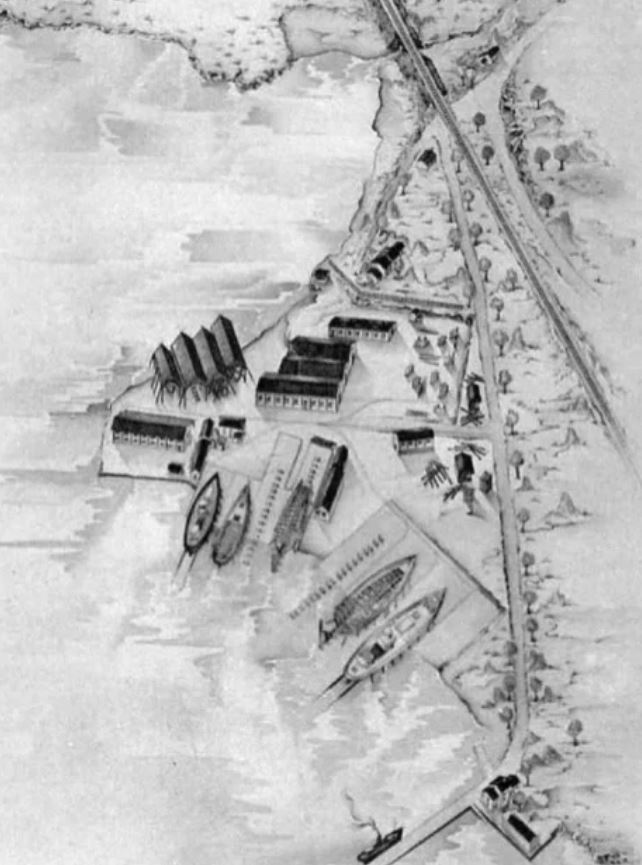
Following the defeat of the Spanish Republicans by General Franco’s Nationalists in 1939, Spain was practically bankrupt. Payments made for arms and support from the various countries and regimes that supported either side had battered the economy, and the various “purges”, street executions of opposition supporters, by both Republicans and Nationalists, would mean large movements of Spanish civilians out of the country trying to escape the violence. It would be international trading that would bring the Spanish economy back to strength, trading with all Europe, and in order to accomplish that, not taking sides with either the Germans or the Allies would be the key
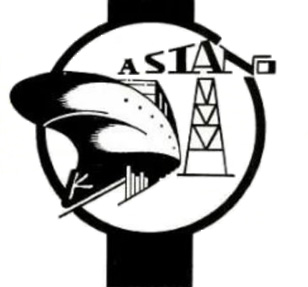
It was into the landscape of political unrest and post-civil war economic austerity that the Astano shipyard had been born in October of 1941. Started in an existing commercial premises on the banks of the Perlio River in Fene by Jose Caruncho (buying a small carpenters yard from Ramon Perez), who, along with his sons Jose & Jacobo, and another half dozen locals, began the repair and, eventually the design and building, of fishing vessels up to 32m in length (Online Resource: fenecom.bogspot.com “Astano in Memory (1), Astano History 1941-2006 1941” Accessed 16/05/2022)

“The company would be controlled as Astilleros y Talleres del Noroeste, SL, in abbreviation it was defined as ASTANO, SL With a duration of twenty years, extendable for the construction and repair of small wooden and steel boats, which would later give way to ships of a certain size. , motivated by the adaptation and expansion of the facilities of its slipway workshops, slipway cars, dry docks and the means of production to the needs of the shipyard” Astano would launch their first fishing vessel a year later in December of 1942, the Comandante Lobo, and by 1943 they had moved from wooden ships to riveted steel hull construction. Astano did well, business was growing and in 1944 they went public as a limited company
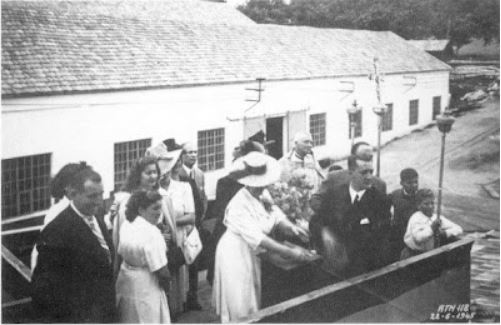
El Condesito began life June 22nd 1945 as the Marujin, sistership to the Rosita Iglesias No2, a Coastal Vessel owned by Enrique Lorenzo registered out of Barcelona, she weighed 168 Tons, and was 41meters from Stern to Bow and powered by a Triple acting Steam Engine pushing 9 Knots through her single prop, but for those of you expecting figures:

The Marujin was a technological leap from her wooden predecessors built at Astano (being a steel hulled, riveted steamship), and would prove her design and serve a long and (presumably) profitable career eventually outlasting her sistership, the Rosita Iglesias (scrapped in Barcelona in July of 1969), by 4 years. It would not be until 1948 that she took on the name we now recognise, El Condesito, when she transferred ownership from Enrique Lorenzo y Compania to the oddly similar Lorenzo Docampo y Compania who would own her until almost the end of her days when, in 1973, she would transfer to Filiberto Lorenzo de Honor……now I am not doubting, for one moment, the legitimacy of these undoubtedly honourable maritime trading edifices…..I am just rather curious as to the continued theme implied by “Lorenzo” in their titles…….however that is another story, bound, and no doubt legally constrained, by the statutes of several sea-faring national interests we will no longer speak of………
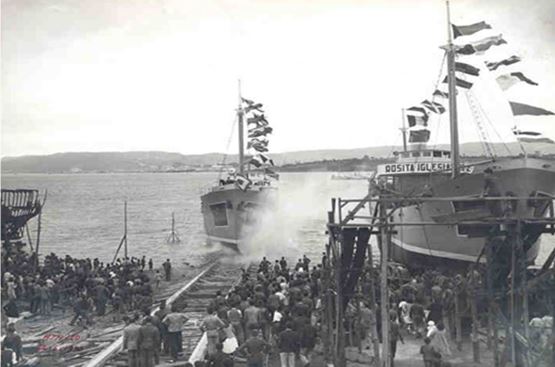
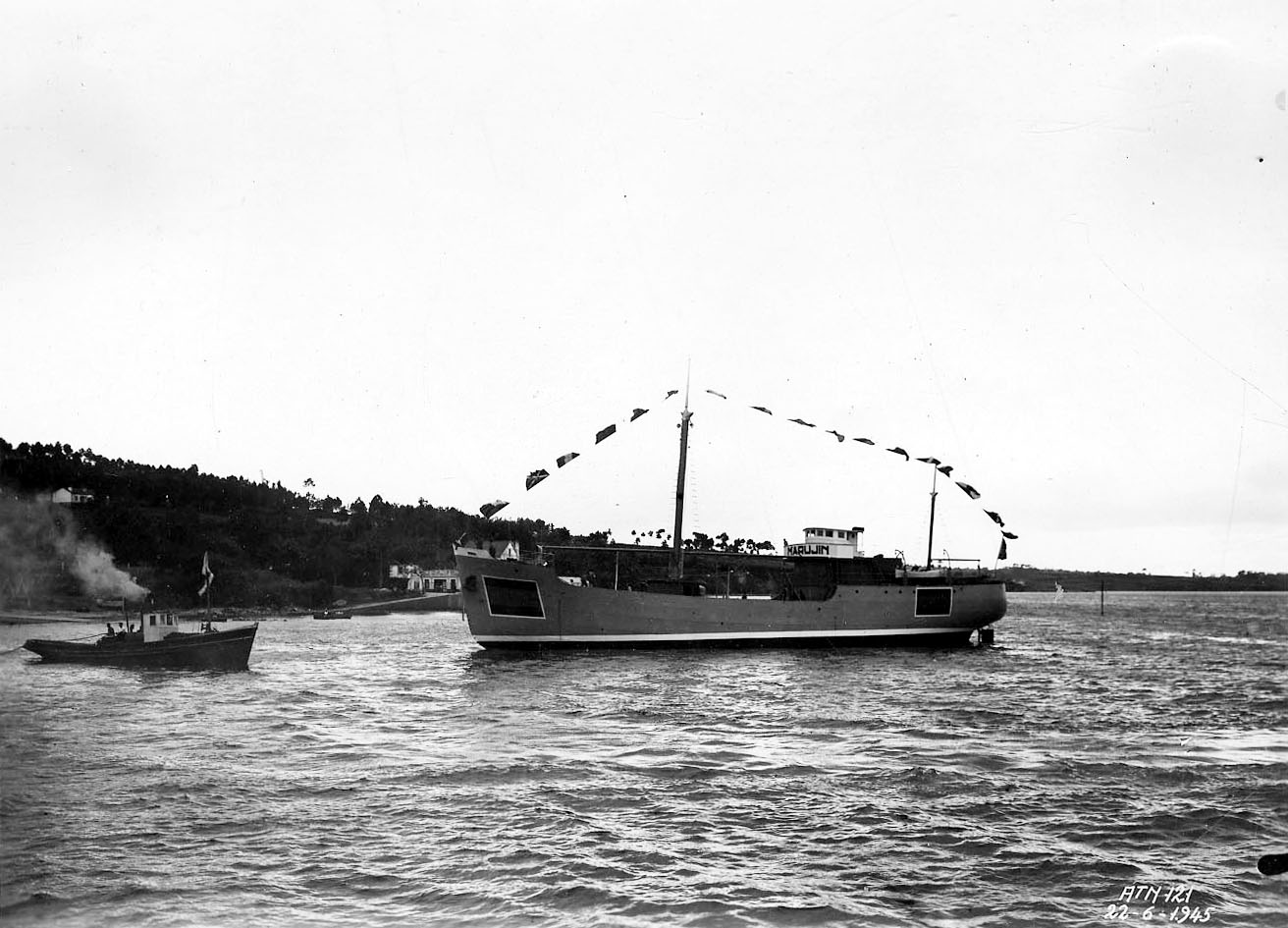
The Marujin was originally owned by the Vigo entrepreneur, Enrique Lorenzo Docampo, a businessman who, like so many of his time started with little and worked his way to fortune, first graduating from art school, then working in the Port and later emigrating to Argentina. Enrique returned to Spain in 1915 at 23 and started a workshop making and repairing steamship boilers

By the 1920’s the workshop, known as “La Vulcano” had 40 workers, branching into railway engine boilers in the ‘30’s and elevating Enrique to become a figurehead of local industry and bringing with that wealth and position. In 1941 Enrique and his chief engineer Florencio Garcia de la Riva established a shipyard, initially repairing wooden hulled ships but launching its own steel hulled vessel in 1948 (VigoEmpresa.com “ENRIQUE LORENZO DOCAMPO MEMORY OF A GREAT VIGUES AND UNIQUE MAN” Online Resource: https://www.vigoempresa.com/enrique-lorenzo-docampomemoria-de-un-gran-vigues-y-hombre-singular/ Accessed 18/05/2022). Enrique never forgot his origins, his factory workers were treated well, Enrique funded a co-operative where the Vulcano Factory workers could take out interest free loans to buy houses, and jobs at Vulcano were considered as lifelong, Enrique seems to have been a man of the people, with a philanthropic side, eventually becoming President of the local provincial council
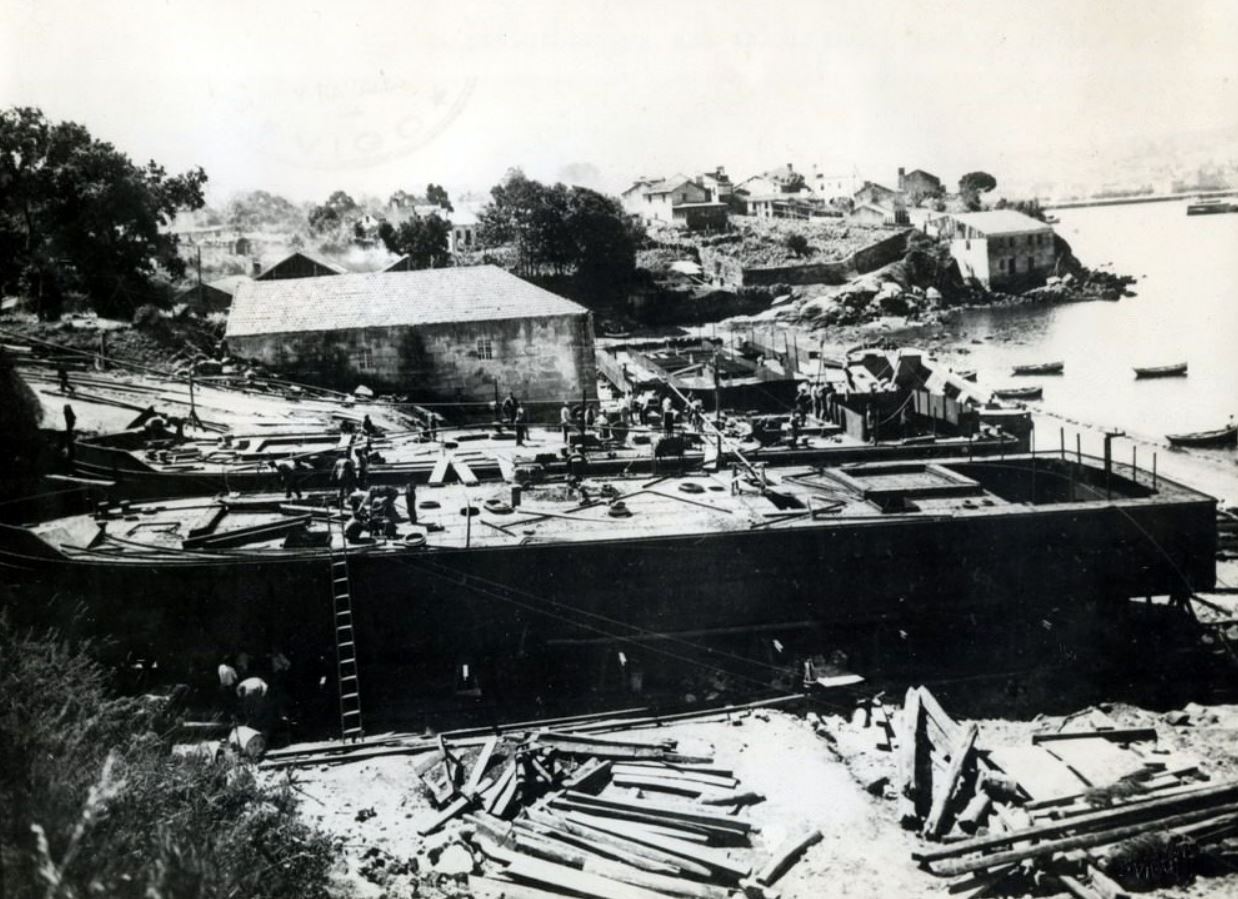
There has been plenty of confusion surrounding the builders of the Marujin, several dive sites and wreck websites continue to state she was built in the Vulcano yards by Enrique’s company, Enrique Lorenzo y Compania, however Lorenzo ordered her built “for” his company, rather than by his company, the reasons seem lost in time, perhaps hidden away in an archive somewhere to this day? The pictures of her launch are distinctly that of the Astano yard, the two buildings noticeable behind the launch party are a clear match for the drawing of Astilleros depicting the yard as it stood in 1943, and even hinting at the sliding doors in the centre of the building. Pictures of the Vulcano yard in the same era would not have had any resemblance as the slipways were not estuarine, as in those at Astillero, but open sea shore at Vulcano. The launch photos of the Marujin also confirm the shipyard slipway at Astillero, the opposite shore of the Perlio river in Fene being clearly visible and again, not in any way resembling the slips of Vulcano. If that is not sufficient for you then the local history of Fene (fenecom.blogspot.com) has the Marujin as Astano yard no NC 007 (although distinctly more Sean Connery’s “Bond” era than Daniel Craig’s)……..
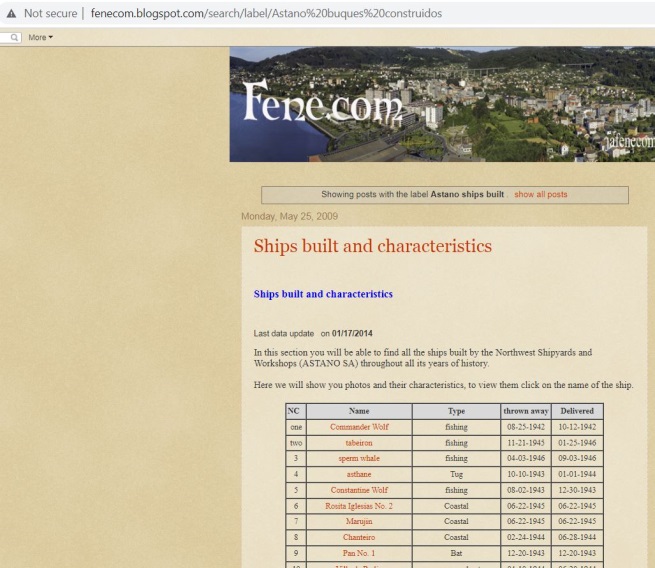
It seems the confusion is easily understood as the current web-site for the Vulcano yard in Spain (Vigo) has a picture of the Marujin docked (see the photo below titled “Marujin Loading at Dockside c1948”) in its “Historical Builds” section (Factorias Vulcano: http://www.factoriasvulcano.com/en/construcciones-historicas “Historical Builds” 1948 Marujin. Online resource: Accessed 25/05/2022) which states: “In 1948, the first vessel built with a 50 metre long steel hulk cargo ship, the MARUJÍN, was delivered.” The key to the confusion being the translation which has the Marujin both “built” and “delivered” the root, it would seem, of the confusion, both in and of itself. Wikipedia does not help as the entry for the Vulcano yard under the 1940’s decade entry (Wikipedia. Online Resource: https://es.wikipedia.org/w/index.php?title=Factor%C3%ADas_Vulcano_S.A.&action=edit§ion=2 Accessed 10/06/2022) states “At the end of this decade, specifically in 1948, the Marujín cargo ship, 50 meters long, was launched. The ship was commissioned by Enrique Lorenzo himself and was later sold to Naviera Condal.” Although again there is no mention of “built” or “constructed” in the translation, however, it does rather imply Enrique Lorenzo commissioned the Marujin from his own Vulcano yard……..

I asked both the shipyards directly, to confirm the Marujin construction with documentary evidence, I remained convinced that the Marujin was built and launched out of the Astano Yard in 1945, and that any work on her associated with the Vulcano yard was, at most, outfitting, or perhaps enhancement. There is a good case for such work to have been carried out as the Marujin started life as a steamship, and was later converted to Oil, as Enrique’s Vulcano yard at Vigo began life making boilers for rail engines and work barges, it would not be inconceivable it was the Vulcano yard that converted the Marujin to a Heavy Oil fired engine, however it seems that did not take place until c1967
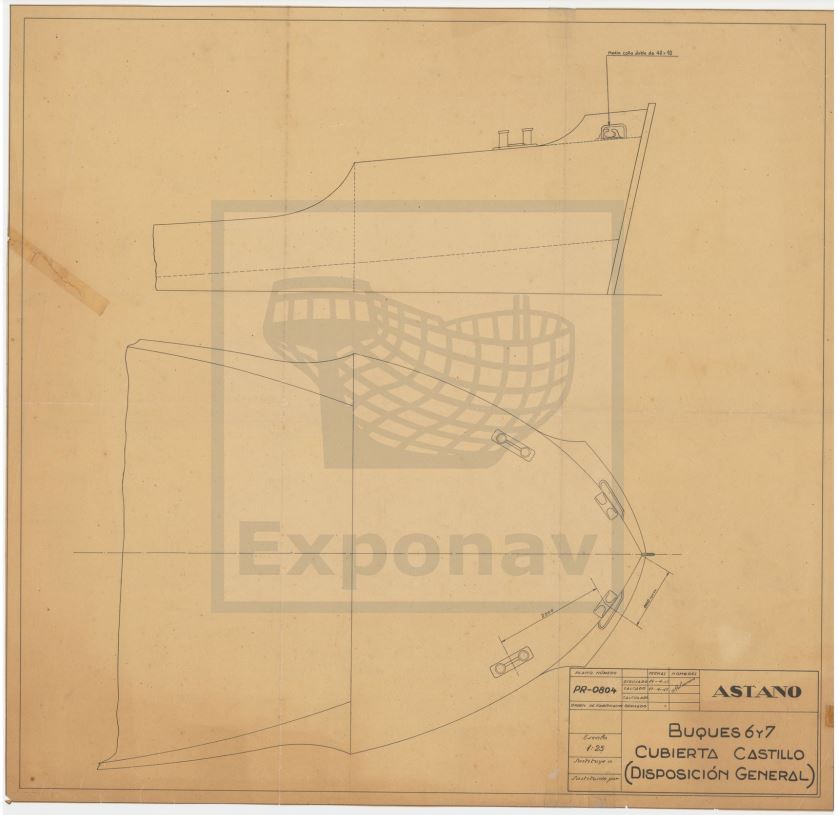
I was delighted when I received an e-mail from Ainhoa Leal Diaz, the documentation librarian at The Exponav Foundation, custodians of the Astano Yard files. Ainhoa confirmed my belief that the Marujin was indeed designed and built at the Astano Yard as NC7 (Her sistership being NC6) of 1944, launched of course, June 22nd 1945! “The ship you are asking about, the Marujín, was indeed built in the shipyard of Astano. This statement is supported by the following information:The existence of a document that contains a list of ships built in the shipyard; among them is the name Marujín together with its assigned construction number, NC7” I was very privilidged to be allowed to look through the archive of documents from the Marujin and her sistership Rosita Iglesias No2 and have been allowed to use a couple of the design arrangement drawings from the archive in this piece. The first is the hull blueprint which details the Marujin’s conservative lines and utilitarian draught
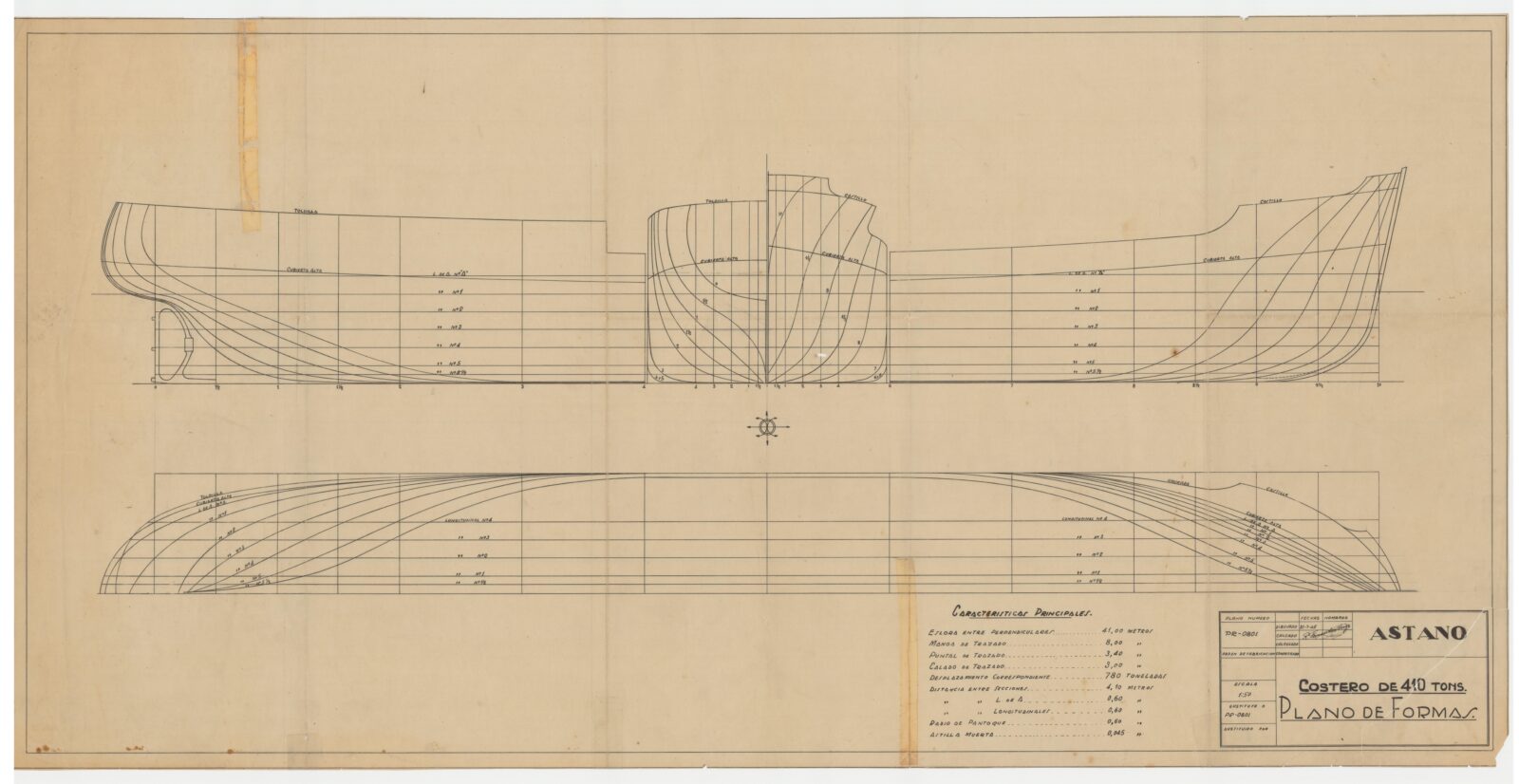
The second is the Steering Arrangement detail drawings showing the Marujin’s Stern Deck, Wheel-House, her quadrant and the steering linkages. The detail is excellent, as that presented in these drawings always is, they fascinate me and not only as a result of my early exposure to the Blue Funnel ships of my father’s years in the merchant navy, but as living history. There is something about the hand drawn nature of the blueprints which harks back to an age when people carried out the work rather than computers, now there is nothing wrong with computers, I wouldn’t be able to write these dives up were it not for my PC, but they are impersonal and technical tools, they are not the stuff of tangible physical remains, not hand drawn in inks and graphite’s by skilled human beings, but more the stuff of the ethereal more metaphysical and of the future. Perhaps I just feel more connected to the past than I do the future, perhaps as we age all of us do…….
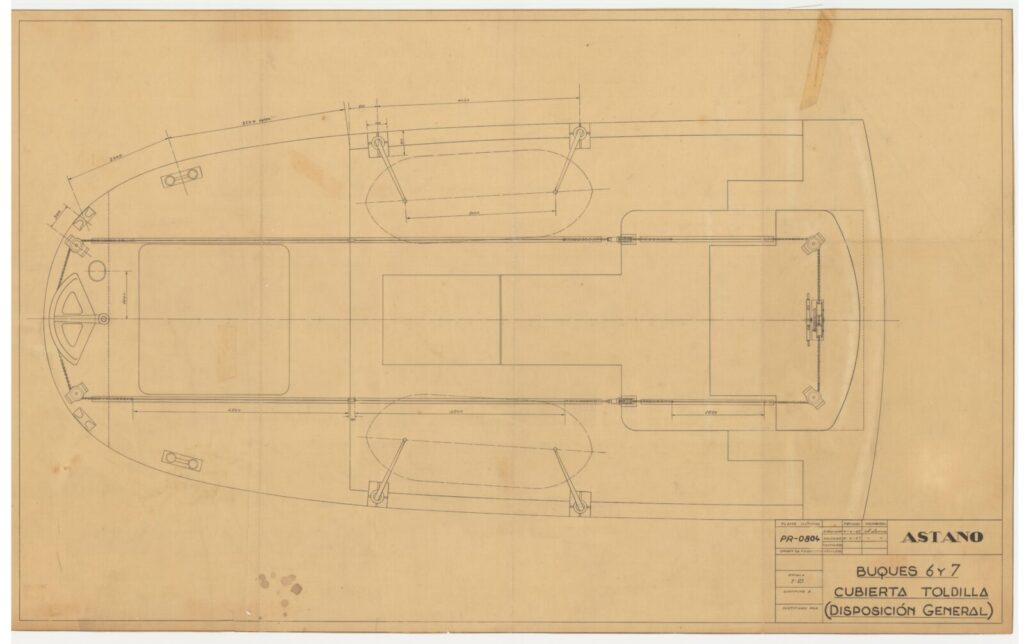
It appears that in 1948 the Marujin was sold to the shipping company Naviera Condal owned by the Condeminas brothers, and based out of Barcelona. At this point she was renamed Condesito, the name she would carry until her eventual loss. The Condesito was re-registered in Barcelona and began sailing in territorial waters on national routes, (“The Little Count” https://www.sacaletatenerife.com/buceo-en-el-condesito/ Online Resource: Accessed 25/05/2022) “….on several occasions they were in the ports of Las Palmas de Gran Canaria and Santa Cruz de Tenerife although they also made frequent trips to the south” going as far as France and Italy. In February of 1970 the Condesito was again sold, this time for around 2.2M Pesetas, at that time around $38.6k, to Naviera La Palmense, becoming part of a fleet of 7 vessels owned by Filiberto Lorenzo de Honor
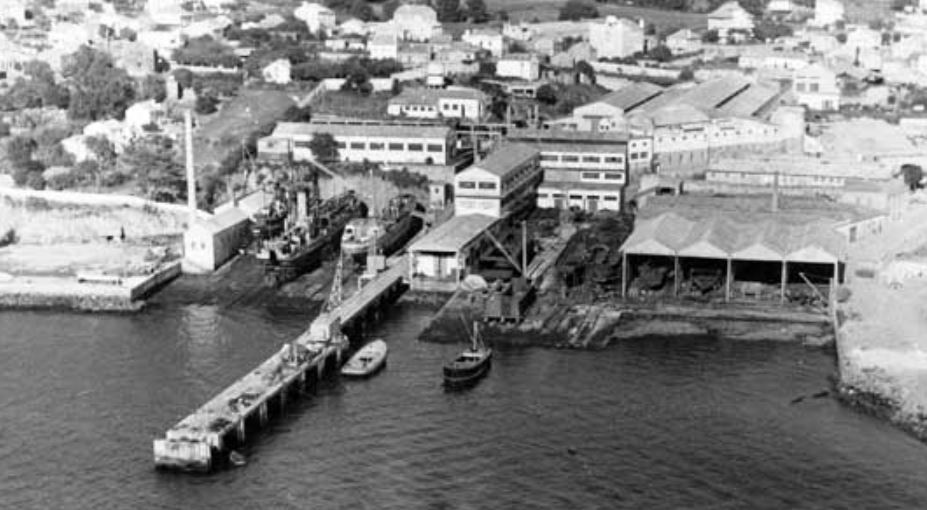
So, digging a little deeper into the maritime history of the Canaries and, specifically, Tenerife, it seems the final owner of the Condesito, Filiberto Lorenzo de Honor, was a figurehead and leading entrepreneur of marine trade on the island. Juan Carlos Diaz Lorenzo, writing in Puente de Mando in August of 2018: “For almost thirty years, the name of Filiberto Lorenzo de Honor was part of the maritime environment of the Canary Islands. Since the beginning of the 1960s, he had become the most important of the 20th-century cabotage palm shipowners” (Diaz J. C. “Protagonists of the Sea: The Palmero Shipowner Filiberto Lorenzo de Honor 1911-1999” Puente de Mando Online Resource: https://www.puentedemando.com/el-armador-palmero-filiberto-lorenzo-de-honor-1911-1999/ Accessed 17/05/2021) It is easy to imagine the man himself from the description of Juan Carlos Diaz Lorenzo, a wild child refusing to be constrained by established dogma, and at 9 years old, on the run from school and fascinated by his father’s contacts as a provisioner of local shipping, stowing away on the steamer Viera y Clavijo and ending up as cabin boy and deck hand…….. These were very different days than the cossetted age we find ourselves in today, an age where adventure was still available, even if, in an era where the sun had actually begun setting on the empire, and some of the colonies were actually in open revolt
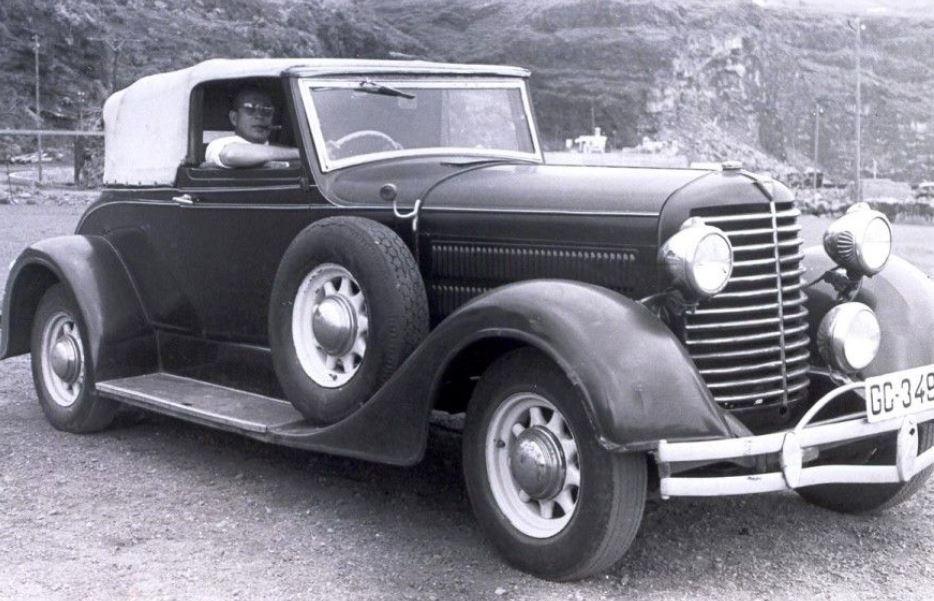
Filiberto sailed with various steamers, from 1920 the Viera y Clavijo and over the next 20 years others owned and run by the Compañía de Vapores Correos Interinsulares Canarios, then in 1930 with the Compañía Trasmediterránea ending up on Álvaro Rodríguez López’s ship “Sancho II” having become an accomplished ship’s cook by that time. Filiberto changed direction at that point and took up running a hotel in La Palma, it may have been the needs of his hotels and those of his peers and his knowledge of the local steamers and their trades, but something pushed Filiberto into ship ownership. Starting small with a motor-sailer in 1947 Filiberto eventually built a small fleet of ships whilst acting as shipping agent for Naviera La Palmense in Santa Cruz de la Palma, by this time, 1955, his fleet comprised of 7 vessels, Guadarrama, Compostelano, Tío Pepe, Airoso, Aranguín, Nicolás Lafuente and Manen
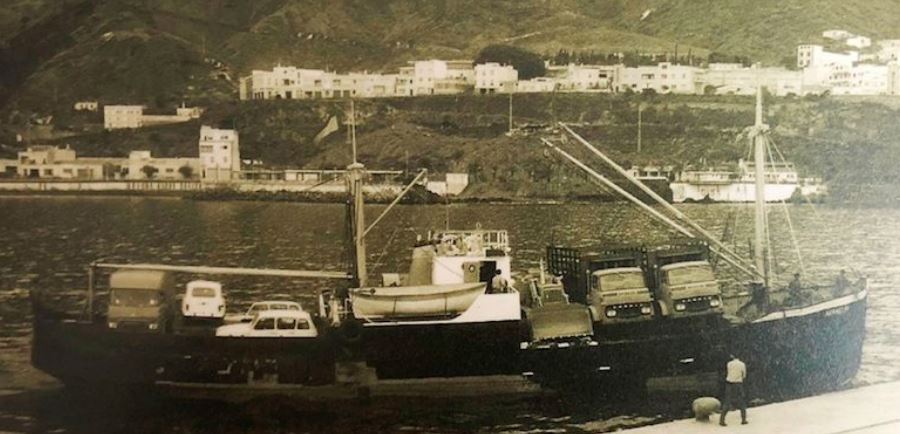
Right up until the 1970’s Filiberto operated his fleet adapting to the emerging requirements of the islands in typical entrepreneurial style, if it was sand required, his ships carried sand, if it was fresh fish, he acquired refrigerated ships, if it was trucks, Filiberto would make use of the tides and ingenuity to off-load using “thick wooden planks” in the absence of cranage (Diaz J. C. “Protagonists of the Sea: The Palmero Shipowner Filiberto Lorenzo de Honor 1911-1999” Puente de Mando Online Resource: https://www.puentedemando.com/el-armador-palmero-filiberto-lorenzo-de-honor-1911-1999/ Accessed 17/05/2021), these were indeed “different times” as Juan Carlos Diaz Lorenzo has it, quoting Filiberto himself “That was – Filiberto himself recalled -, on the one hand, ignorance and on the other, the desire to make money.”
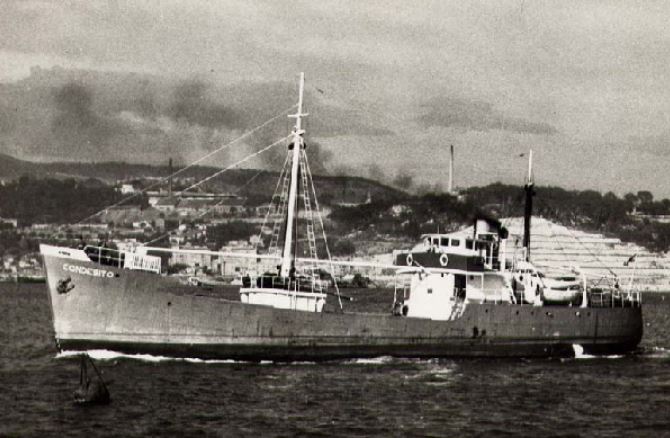
By 1970 Filiberto’s son, also Filiberto, was now manager of the fleet and bought several ships to supplement it, one of which was the Condesito, acquired in 1970 from the Naviera Condal Company of Barcelona. The Condesito would now find herself shipping cargoes under the ownership of Naviera La Palmense, for Americans, leased out at $300 per day to carry “provisions and water from the palms of Gran Canaria to different farms in the areas of Tarfaya and Agadir. (Morocco).” That wasn’t the only cargo she carried as it is also noted she carried “tubes” and “dynamite” although what type of tubes is not distinct and might easily have been anything from tyres to water pipes. The routes the Condesito sailed broadened too, she would now not only call at Las Palmas, Los Cristianos and Santa Cruz, but wider afield from Barcelona to the Levant (Istanbul), Spanish Sahara, the Canaries and Cape Verde, adventurous, perhaps even ambitious for a modest 43M, 28 year old veteran coaster……..
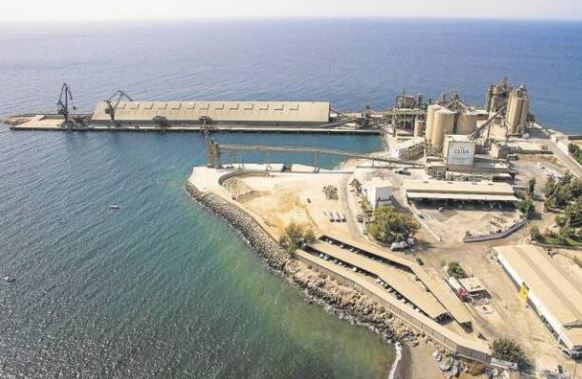
The evening of September 27, 1973 should have been no different than any other for the Condesito, she had sailed from the Arguineguin cement factory at El Pajar, Gran Canaria, with full holds of bagged cement, intended to help expand the tourist hotels and infrastructure, and desperately needed to meet the demands of the ever increasing tourist trade on the island of Tenerife. The Condesito was approaching the port at Los Cristianos in what some say was a storm, there are conflicting reports of the events, some describe Condesito colliding with the rocks in the Punta Rasca area, just a mile from her final destination, some suggest the crew abandoned the vessel deliberately, with her insurance to claim, and still others argue that her steering failed and that drove her onto the rocks. I can find no mention of a storm in September of 1973 in the Los Cristianos area, that does not mean a local storm did not occur, there are limitations to any non-native trying to identify events, especially with no local contacts to provide an insight to those long lost news sources from the day, more so as that person is also not a Spanish speaker ……… On the realisation the Condesito was floundering, Local fishermen and maritime services tried to save her, but it seems nothing could be done for the Condesito, she ended up firmly stuck on the rock outcrops of Punta Rasca. The remaining crew, although there is no mention of who or indeed how many, abandoned the Condesito on the morning of the 28th of September of 1973, when those attempting to save the ship became convinced she might break her back. It only took a few hours more before Condesito lost her fight for survival and slipped beneath the seas where she lies today, broken, and abandoned, save by those she draws in to dive her……….
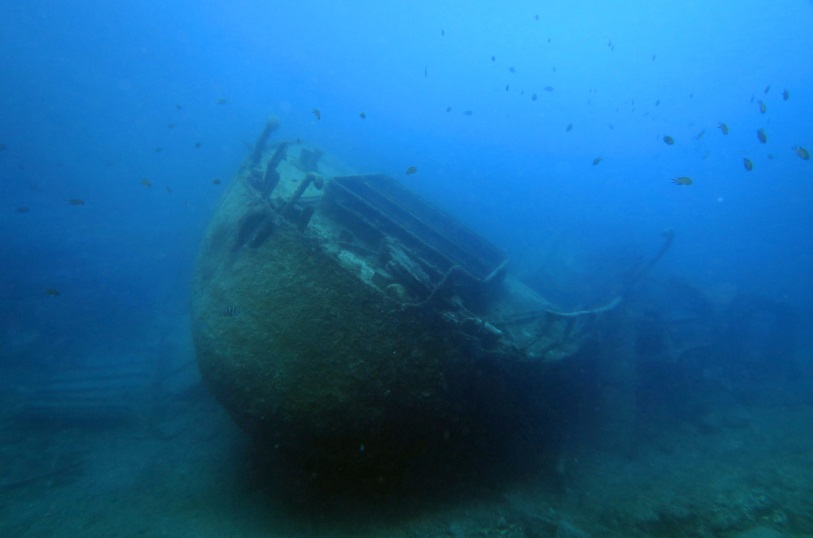
I dived the Condesito with some of FSAC who had joined me and my family for an early sun seeking dive break April of 2005. As I recall it there was Tracy, Jim, Rob and myself and we used Calipso Diving on the recommendation of Jason, one of my Divemasters and his then girlfriend Nerina, both of whom had moved out to work for Calipso as dive guides for a couple of years, but were back in the UK at the time to see relatives. My Navy Log records “07/04/05 TENERIFE “Condesito” Los Cristianos Ten minute rib ride out to the right of a small harbour near Los Galetas, past the cactus and palm farm. Spent 15 mins in the gullys with all kinds of small tropical fish – most notable were the pipe-fish the biggest I’ve seen at near 1m long. Some smaller ½ m Barracuda & plenty of Urchins & their small black & blue fish. The Condesito was carrying cement & ran aground near the shore, broken & battered- no bows just the stern but wonderfully sited & a photographers dream. Plenty to get inside for & well worth a few more dives Air In 230 Out 90 Buddy Tim”
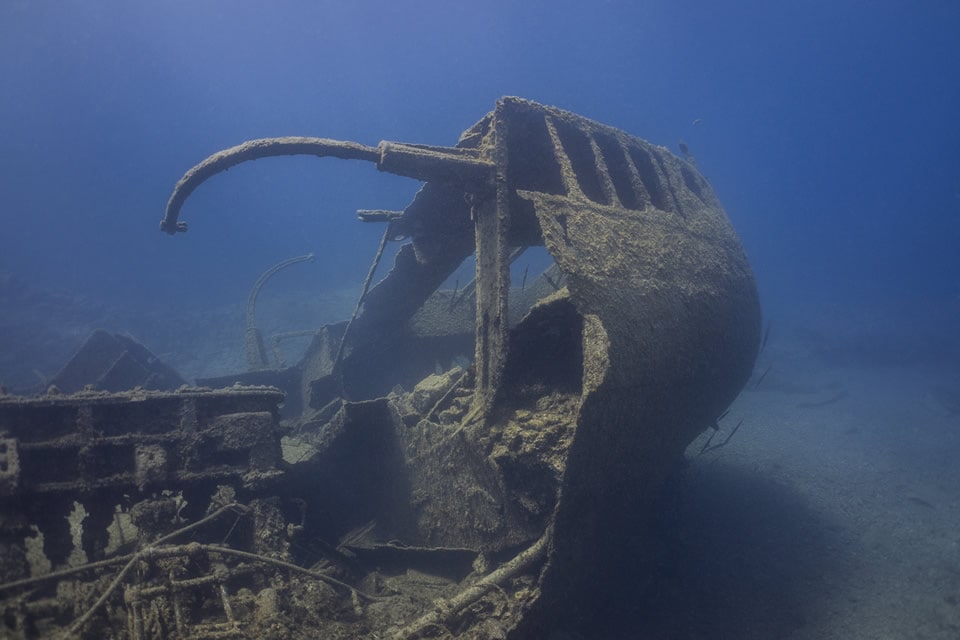
Another of my rather short descriptives, lacking much in detail considering I really liked this wreck which I remember quite vividly as being lit marvelously whilst we dived her. She only sits at the deepest in 25 or so meters of water, and the light dances on her making her a very picture perfect wreck. I recall her hull being broken but still in line with her stern at the time and much of it still vertical, there being a host of small fish sheltering amongst the debris
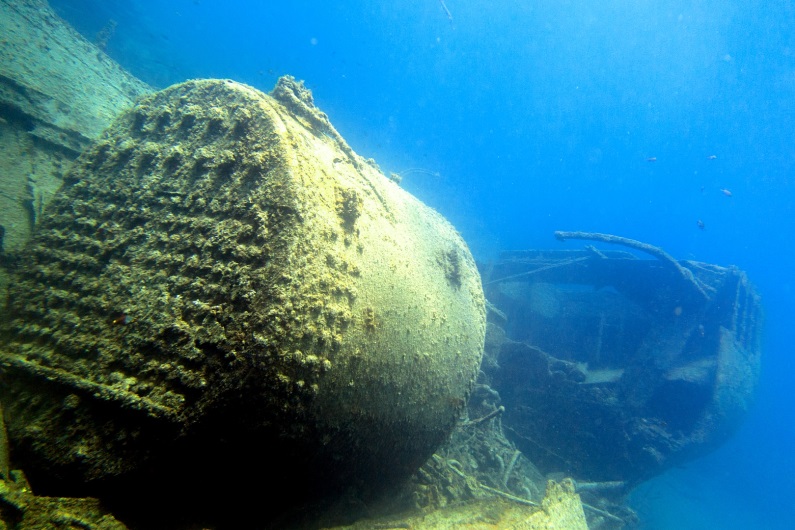
I enjoyed the dive at the time but looking at modern pictures of her she was not as broken when we dived her, I recall more of her hull being upright along her length at least, and her engine not being as exposed as it clearly is more recently. I cannot remember the boiler being exposed to the same extent either, so I have a picture in my mind of more of her structure being almost intact along her hull. Clearly time makes a difference, the photos here are more likely 2020 or so and our dive was a good 15 years earlier, it is hardly strange that she has become far more broken than I recall
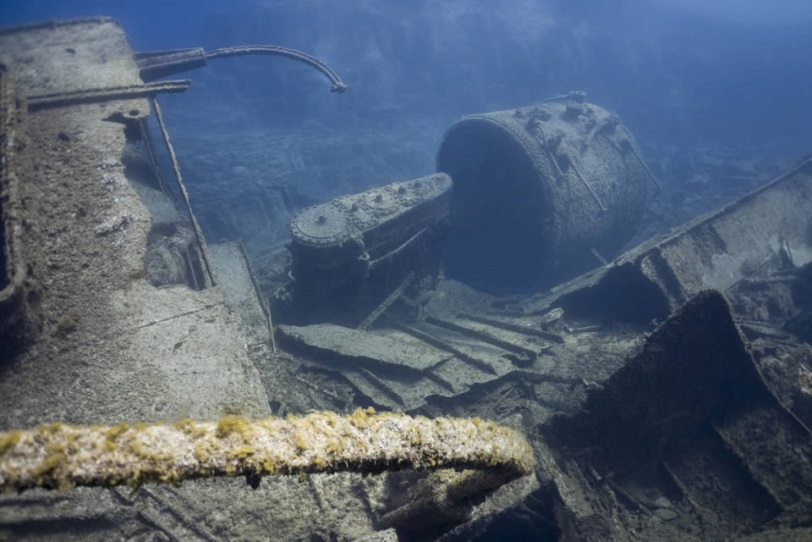
Whatever the condition of the Condesito now, she is still an interesting wreck, the opportunities to get in and around her clearly a lot safer than when more of her hull was intact. There was only the one opportunity to dive her at the time, we had another, deeper wreck to visit the next day, so our dive was restricted by common sense and was limited to runs around her and, even then the limited penetration that might have been rewarding on the day, went unmentioned in my log. I recall mainly the deck, and the gully she lay in as dive runs, I remember her prop and rudder, vaguely, but can’t see any sign of them on the shots I can find on the websites and, sadly, Jason has nothing in his photo archive on the little wreck we enjoyed in the flashing of sun-beams, dancing in the shallow gully we found Condesito resting in that April morning in 2005
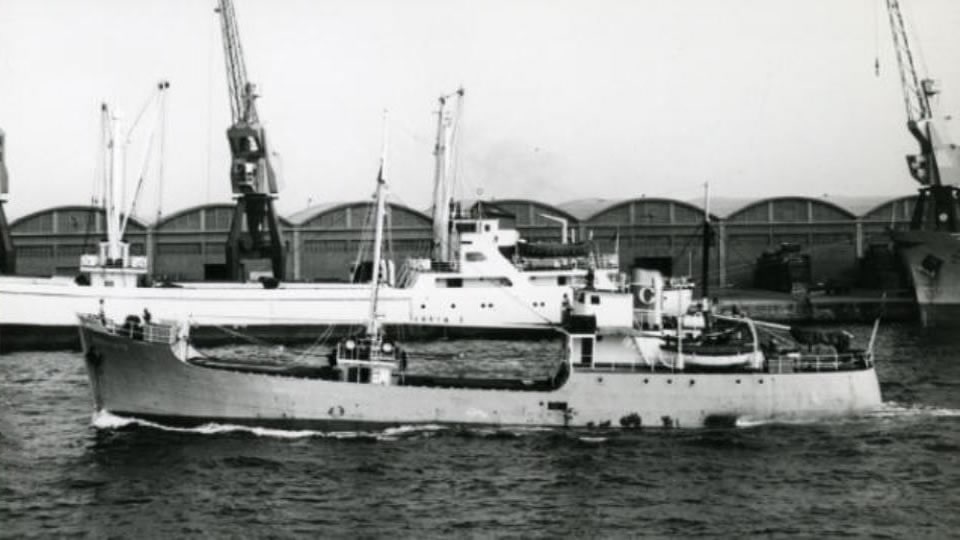
As ever this piece would not be as complete as it is without the help and generosity of those who have contributed to it. My personal thanks go to Harry Bakker of Aquarius Diving in Tenerife www.aquarius-divingtenerife.com for the use of his excellent photos, and to Ainhoa Leal Diaz of the Exponav Foundation www.exponav.org for the information, launch photos and blueprints of the Marujin used in the piece
